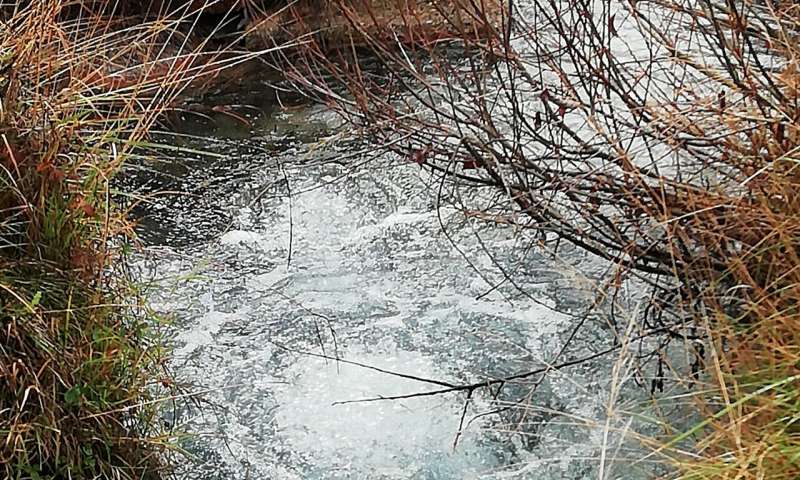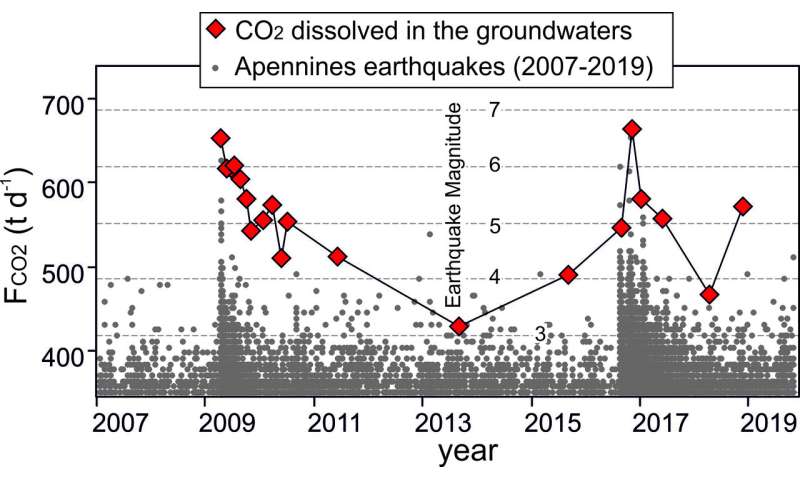Increase in release of underground CO2 emissions in Italy tied to earthquakes
by Bob Yirka , Phys.org
 The amount of CO2 dissolved in groundwater is so large that, in some cases, strong free CO2 emissions are associated with the water discharges. The emission in the picture is located at San Vittorino plain (Rieti) about 30 km far from the epicenter of the April 2009 L’Aquila earthquake. Credit: Giovanni Chiodini - INGV (first author)
The amount of CO2 dissolved in groundwater is so large that, in some cases, strong free CO2 emissions are associated with the water discharges. The emission in the picture is located at San Vittorino plain (Rieti) about 30 km far from the epicenter of the April 2009 L’Aquila earthquake. Credit: Giovanni Chiodini - INGV (first author)A team of researchers affiliated with several institutions in Italy has found a possible link between increases in CO2 emissions from groundwater and earthquake occurrences in Italy's Apennine Mountains. In their paper published in the journal Science Advances, the group describes their decade-long study of CO2 emissions in the area and what they learned about them.
Prior research has shown that carbon dioxide in the air can become trapped in rocks—the resulting rocks are known as carbonates.Additionally, the carbon dioxide in those rocks can be released by heat from within the Earth and other tectonic forces. When the carbon is released, it tends to be sequestered in pockets belowground or in underground reservoirs. Carbon that makes its way into such reservoirs quite often ends up in the nearby water table, and can rise to the surface via springs. In this new effort, the researchers studied fluctuations in the amount of carbon dioxide being released from spring water at several sites in the Apennine Mountains near the site of the 2009 L'Aquila earthquake. They did so by collecting samples over the years 2009 to 2018.
As part of their study of the samples they collected, the researchers also looked at seismic data, which, in addition to normal seismic events, also showed occurrences of several small earthquakes. They found that levels of CO2 emissions from spring water in the area rose when there were earthquakes and then dropped again after the quakes were over. More specifically, they found that when quakes of magnitude 6 or higher struck, CO2 emission levels rose to an average of 600 metric tons per day. During quiet periods, CO2 emissions in the same area were typically between 400 and 500 metric tons per day.
The researchers suggest that pressure created by increases in CO2 gas underground might be the factor setting off the earthquakes. They further suggest that if CO2 does set off some earthquakes, measuring it might be a way of predicting some of them. They also note that their findings highlight a source of carbon emissions into the atmosphere that needs to be added to global warming models.

In the Apennine mountains (Italy), the emission of CO2 of deep origin is well correlated with earthquakes occurrence during the last decade. In fact, during 2007-2019, the seismic events (including the destructive events of 2009 and 2016) were accompanied by evident peaks in the amount of deep CO2 dissolved and transported by the groundwaters in the area. In the diagram FCO2 (t d-1) indicates the total amount of CO2 discharged by the large springs in tons per day. Credit: Giovanni Chiodini - INGV (first author)
Explore further
Explore further
Study shows global warming could push methane emissions from wetlands 50 to 80 percent higher
More information: G. Chiodini et al. Correlation between tectonic CO2 Earth degassing and seismicity is revealed by a 10-year record in the Apennines, Italy, Science Advances (2020). DOI: 10.1126/sciadv.abc2938
Journal information: Science Advances
© 2020 Science X Network
More information: G. Chiodini et al. Correlation between tectonic CO2 Earth degassing and seismicity is revealed by a 10-year record in the Apennines, Italy, Science Advances (2020). DOI: 10.1126/sciadv.abc2938
Journal information: Science Advances
© 2020 Science X Network
No comments:
Post a Comment